Strategic Construction Procurement Report: Critical Review Analysis
VerifiedAdded on 2021/04/16
|9
|1653
|27
Report
AI Summary
This report provides a critical analysis of strategic construction procurement, focusing on Public-Private Partnerships (PPPs) and Private Finance Initiatives (PFIs) within the UK construction industry. It examines four key research papers, each addressing different aspects of PPPs. The first review explores the evolution and cost-effectiveness of PPPs in Britain, while the second paper investigates relationship management in PFI/PPP projects. The third review analyzes risk allocation in these projects, identifying risks that should be retained by the public sector. Finally, the fourth review examines transaction costs and relational contracting in PPPs, particularly in the UK defense sector. The report synthesizes these reviews to provide a comprehensive understanding of the challenges and opportunities associated with strategic construction procurement, highlighting the importance of careful consideration of all aspects to ensure economic success. This report is contributed by a student to be published on Desklib, a platform which provides all the necessary AI based study tools for students.

Running head: STRATEGIC CONSTRUCTION PROCUREMENT
Strategic Construction Procurement
Name of the Student
Name of the University
Author’s Note
Strategic Construction Procurement
Name of the Student
Name of the University
Author’s Note
Paraphrase This Document
Need a fresh take? Get an instant paraphrase of this document with our AI Paraphraser

1STRATEGIC CONSTRUCTION PROCUREMENT
Table of Contents
Introduction......................................................................................................................................2
CRITICAL REVIEW 1...................................................................................................................2
CRITICAL REVIEW 2...................................................................................................................3
CRITICAL REVIEW 3...................................................................................................................5
CRITICAL REVIEW 4...................................................................................................................6
References........................................................................................................................................8
Table of Contents
Introduction......................................................................................................................................2
CRITICAL REVIEW 1...................................................................................................................2
CRITICAL REVIEW 2...................................................................................................................3
CRITICAL REVIEW 3...................................................................................................................5
CRITICAL REVIEW 4...................................................................................................................6
References........................................................................................................................................8
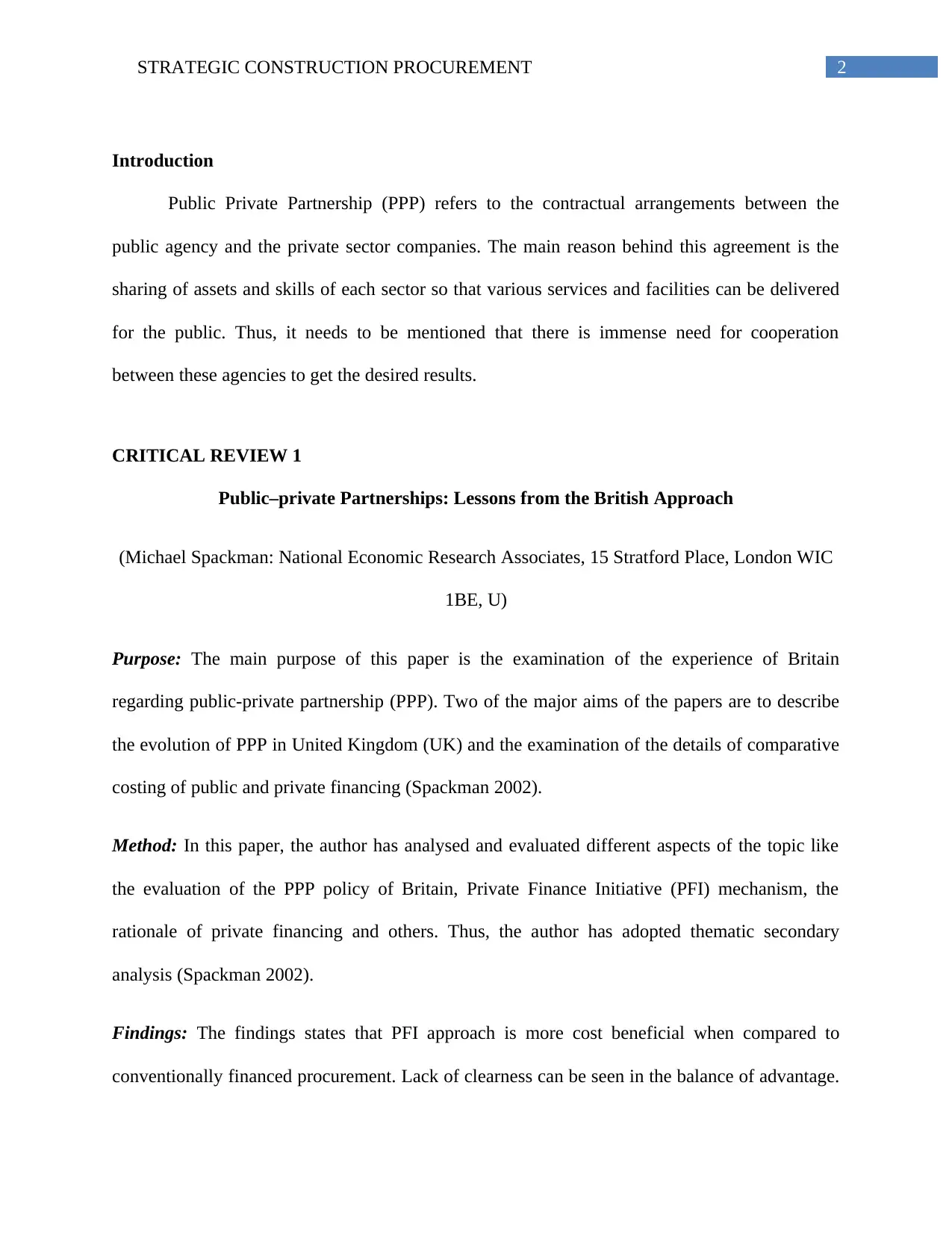
2STRATEGIC CONSTRUCTION PROCUREMENT
Introduction
Public Private Partnership (PPP) refers to the contractual arrangements between the
public agency and the private sector companies. The main reason behind this agreement is the
sharing of assets and skills of each sector so that various services and facilities can be delivered
for the public. Thus, it needs to be mentioned that there is immense need for cooperation
between these agencies to get the desired results.
CRITICAL REVIEW 1
Public–private Partnerships: Lessons from the British Approach
(Michael Spackman: National Economic Research Associates, 15 Stratford Place, London WIC
1BE, U)
Purpose: The main purpose of this paper is the examination of the experience of Britain
regarding public-private partnership (PPP). Two of the major aims of the papers are to describe
the evolution of PPP in United Kingdom (UK) and the examination of the details of comparative
costing of public and private financing (Spackman 2002).
Method: In this paper, the author has analysed and evaluated different aspects of the topic like
the evaluation of the PPP policy of Britain, Private Finance Initiative (PFI) mechanism, the
rationale of private financing and others. Thus, the author has adopted thematic secondary
analysis (Spackman 2002).
Findings: The findings states that PFI approach is more cost beneficial when compared to
conventionally financed procurement. Lack of clearness can be seen in the balance of advantage.
Introduction
Public Private Partnership (PPP) refers to the contractual arrangements between the
public agency and the private sector companies. The main reason behind this agreement is the
sharing of assets and skills of each sector so that various services and facilities can be delivered
for the public. Thus, it needs to be mentioned that there is immense need for cooperation
between these agencies to get the desired results.
CRITICAL REVIEW 1
Public–private Partnerships: Lessons from the British Approach
(Michael Spackman: National Economic Research Associates, 15 Stratford Place, London WIC
1BE, U)
Purpose: The main purpose of this paper is the examination of the experience of Britain
regarding public-private partnership (PPP). Two of the major aims of the papers are to describe
the evolution of PPP in United Kingdom (UK) and the examination of the details of comparative
costing of public and private financing (Spackman 2002).
Method: In this paper, the author has analysed and evaluated different aspects of the topic like
the evaluation of the PPP policy of Britain, Private Finance Initiative (PFI) mechanism, the
rationale of private financing and others. Thus, the author has adopted thematic secondary
analysis (Spackman 2002).
Findings: The findings states that PFI approach is more cost beneficial when compared to
conventionally financed procurement. Lack of clearness can be seen in the balance of advantage.
⊘ This is a preview!⊘
Do you want full access?
Subscribe today to unlock all pages.

Trusted by 1+ million students worldwide
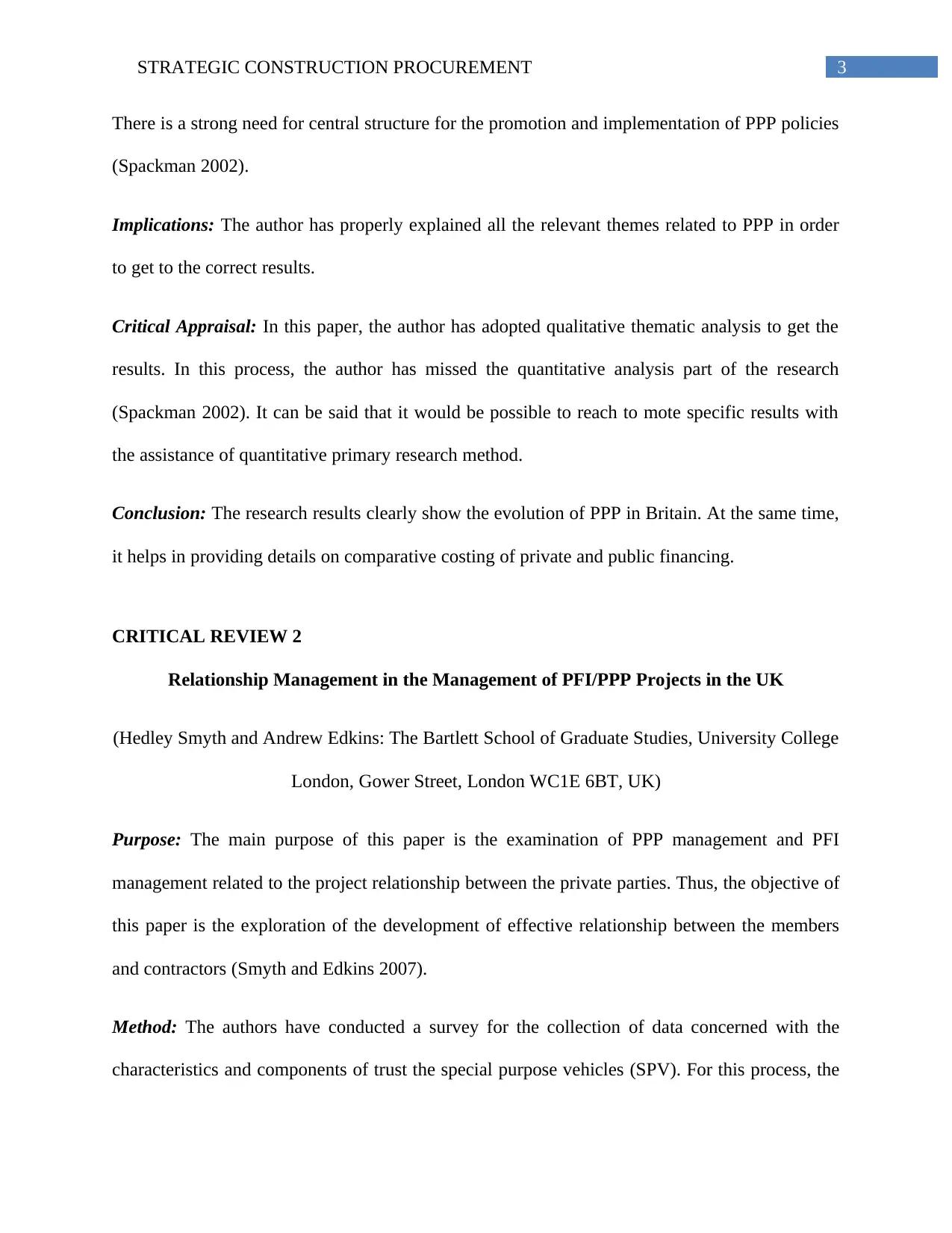
3STRATEGIC CONSTRUCTION PROCUREMENT
There is a strong need for central structure for the promotion and implementation of PPP policies
(Spackman 2002).
Implications: The author has properly explained all the relevant themes related to PPP in order
to get to the correct results.
Critical Appraisal: In this paper, the author has adopted qualitative thematic analysis to get the
results. In this process, the author has missed the quantitative analysis part of the research
(Spackman 2002). It can be said that it would be possible to reach to mote specific results with
the assistance of quantitative primary research method.
Conclusion: The research results clearly show the evolution of PPP in Britain. At the same time,
it helps in providing details on comparative costing of private and public financing.
CRITICAL REVIEW 2
Relationship Management in the Management of PFI/PPP Projects in the UK
(Hedley Smyth and Andrew Edkins: The Bartlett School of Graduate Studies, University College
London, Gower Street, London WC1E 6BT, UK)
Purpose: The main purpose of this paper is the examination of PPP management and PFI
management related to the project relationship between the private parties. Thus, the objective of
this paper is the exploration of the development of effective relationship between the members
and contractors (Smyth and Edkins 2007).
Method: The authors have conducted a survey for the collection of data concerned with the
characteristics and components of trust the special purpose vehicles (SPV). For this process, the
There is a strong need for central structure for the promotion and implementation of PPP policies
(Spackman 2002).
Implications: The author has properly explained all the relevant themes related to PPP in order
to get to the correct results.
Critical Appraisal: In this paper, the author has adopted qualitative thematic analysis to get the
results. In this process, the author has missed the quantitative analysis part of the research
(Spackman 2002). It can be said that it would be possible to reach to mote specific results with
the assistance of quantitative primary research method.
Conclusion: The research results clearly show the evolution of PPP in Britain. At the same time,
it helps in providing details on comparative costing of private and public financing.
CRITICAL REVIEW 2
Relationship Management in the Management of PFI/PPP Projects in the UK
(Hedley Smyth and Andrew Edkins: The Bartlett School of Graduate Studies, University College
London, Gower Street, London WC1E 6BT, UK)
Purpose: The main purpose of this paper is the examination of PPP management and PFI
management related to the project relationship between the private parties. Thus, the objective of
this paper is the exploration of the development of effective relationship between the members
and contractors (Smyth and Edkins 2007).
Method: The authors have conducted a survey for the collection of data concerned with the
characteristics and components of trust the special purpose vehicles (SPV). For this process, the
Paraphrase This Document
Need a fresh take? Get an instant paraphrase of this document with our AI Paraphraser
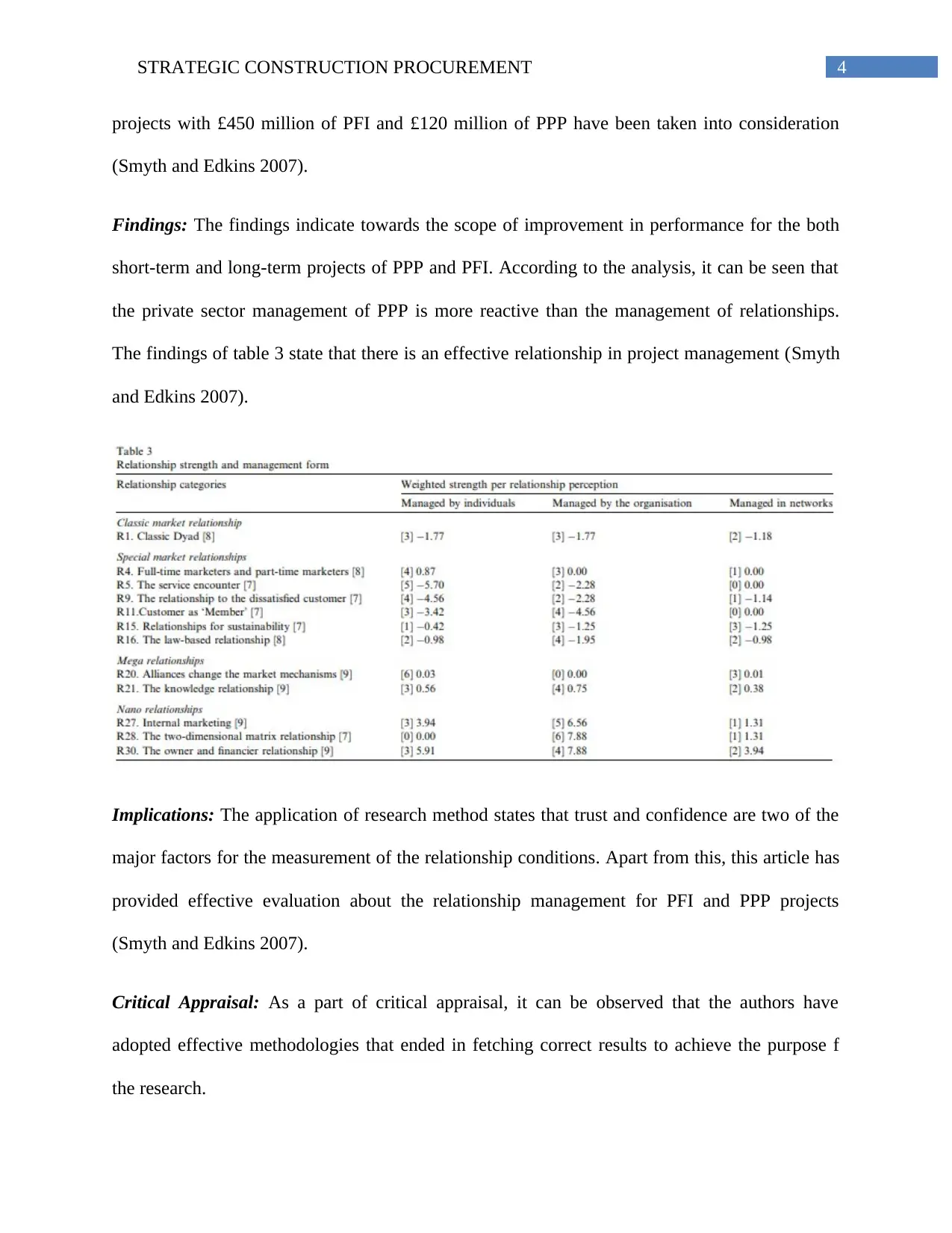
4STRATEGIC CONSTRUCTION PROCUREMENT
projects with £450 million of PFI and £120 million of PPP have been taken into consideration
(Smyth and Edkins 2007).
Findings: The findings indicate towards the scope of improvement in performance for the both
short-term and long-term projects of PPP and PFI. According to the analysis, it can be seen that
the private sector management of PPP is more reactive than the management of relationships.
The findings of table 3 state that there is an effective relationship in project management (Smyth
and Edkins 2007).
Implications: The application of research method states that trust and confidence are two of the
major factors for the measurement of the relationship conditions. Apart from this, this article has
provided effective evaluation about the relationship management for PFI and PPP projects
(Smyth and Edkins 2007).
Critical Appraisal: As a part of critical appraisal, it can be observed that the authors have
adopted effective methodologies that ended in fetching correct results to achieve the purpose f
the research.
projects with £450 million of PFI and £120 million of PPP have been taken into consideration
(Smyth and Edkins 2007).
Findings: The findings indicate towards the scope of improvement in performance for the both
short-term and long-term projects of PPP and PFI. According to the analysis, it can be seen that
the private sector management of PPP is more reactive than the management of relationships.
The findings of table 3 state that there is an effective relationship in project management (Smyth
and Edkins 2007).
Implications: The application of research method states that trust and confidence are two of the
major factors for the measurement of the relationship conditions. Apart from this, this article has
provided effective evaluation about the relationship management for PFI and PPP projects
(Smyth and Edkins 2007).
Critical Appraisal: As a part of critical appraisal, it can be observed that the authors have
adopted effective methodologies that ended in fetching correct results to achieve the purpose f
the research.
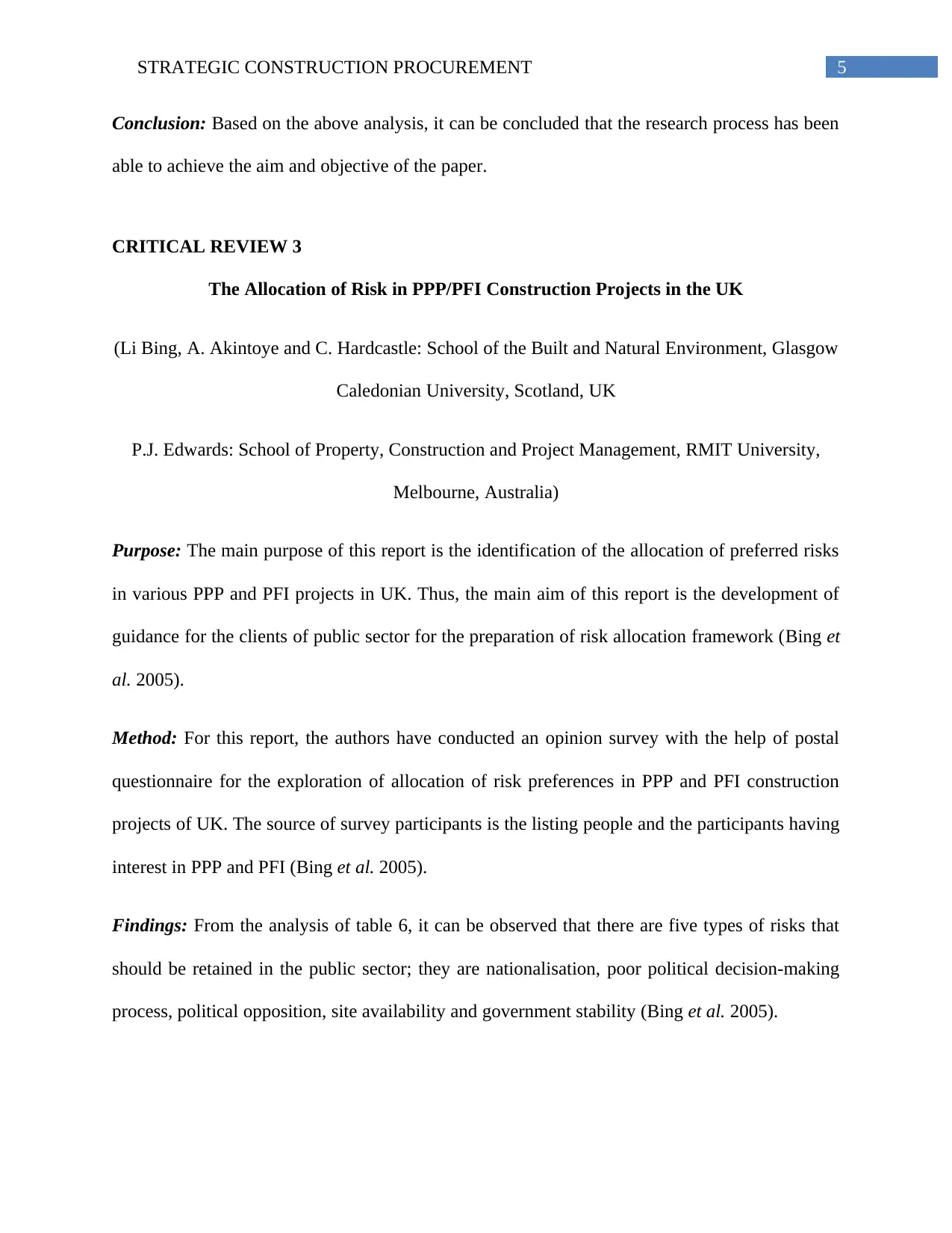
5STRATEGIC CONSTRUCTION PROCUREMENT
Conclusion: Based on the above analysis, it can be concluded that the research process has been
able to achieve the aim and objective of the paper.
CRITICAL REVIEW 3
The Allocation of Risk in PPP/PFI Construction Projects in the UK
(Li Bing, A. Akintoye and C. Hardcastle: School of the Built and Natural Environment, Glasgow
Caledonian University, Scotland, UK
P.J. Edwards: School of Property, Construction and Project Management, RMIT University,
Melbourne, Australia)
Purpose: The main purpose of this report is the identification of the allocation of preferred risks
in various PPP and PFI projects in UK. Thus, the main aim of this report is the development of
guidance for the clients of public sector for the preparation of risk allocation framework (Bing et
al. 2005).
Method: For this report, the authors have conducted an opinion survey with the help of postal
questionnaire for the exploration of allocation of risk preferences in PPP and PFI construction
projects of UK. The source of survey participants is the listing people and the participants having
interest in PPP and PFI (Bing et al. 2005).
Findings: From the analysis of table 6, it can be observed that there are five types of risks that
should be retained in the public sector; they are nationalisation, poor political decision-making
process, political opposition, site availability and government stability (Bing et al. 2005).
Conclusion: Based on the above analysis, it can be concluded that the research process has been
able to achieve the aim and objective of the paper.
CRITICAL REVIEW 3
The Allocation of Risk in PPP/PFI Construction Projects in the UK
(Li Bing, A. Akintoye and C. Hardcastle: School of the Built and Natural Environment, Glasgow
Caledonian University, Scotland, UK
P.J. Edwards: School of Property, Construction and Project Management, RMIT University,
Melbourne, Australia)
Purpose: The main purpose of this report is the identification of the allocation of preferred risks
in various PPP and PFI projects in UK. Thus, the main aim of this report is the development of
guidance for the clients of public sector for the preparation of risk allocation framework (Bing et
al. 2005).
Method: For this report, the authors have conducted an opinion survey with the help of postal
questionnaire for the exploration of allocation of risk preferences in PPP and PFI construction
projects of UK. The source of survey participants is the listing people and the participants having
interest in PPP and PFI (Bing et al. 2005).
Findings: From the analysis of table 6, it can be observed that there are five types of risks that
should be retained in the public sector; they are nationalisation, poor political decision-making
process, political opposition, site availability and government stability (Bing et al. 2005).
⊘ This is a preview!⊘
Do you want full access?
Subscribe today to unlock all pages.

Trusted by 1+ million students worldwide
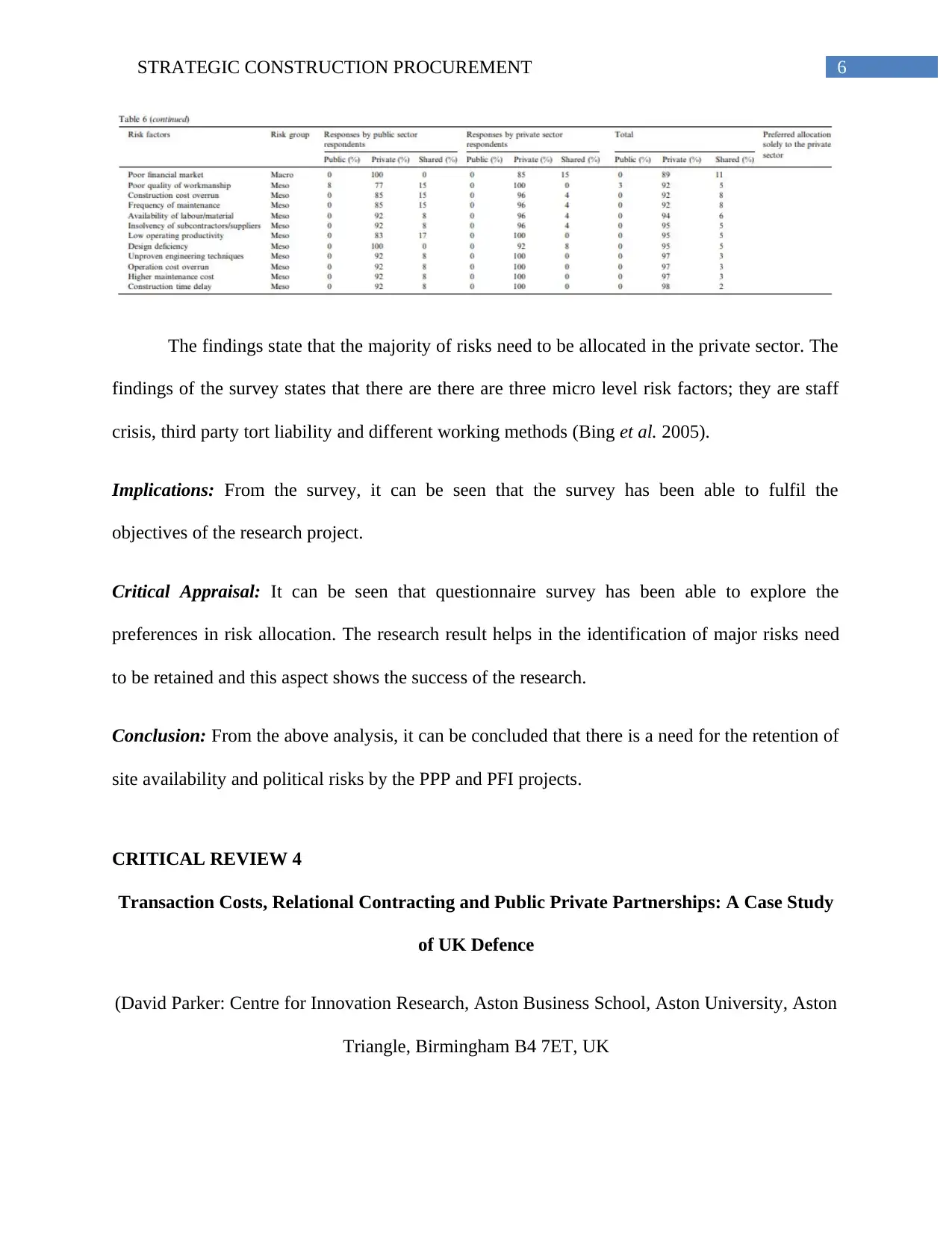
6STRATEGIC CONSTRUCTION PROCUREMENT
The findings state that the majority of risks need to be allocated in the private sector. The
findings of the survey states that there are there are three micro level risk factors; they are staff
crisis, third party tort liability and different working methods (Bing et al. 2005).
Implications: From the survey, it can be seen that the survey has been able to fulfil the
objectives of the research project.
Critical Appraisal: It can be seen that questionnaire survey has been able to explore the
preferences in risk allocation. The research result helps in the identification of major risks need
to be retained and this aspect shows the success of the research.
Conclusion: From the above analysis, it can be concluded that there is a need for the retention of
site availability and political risks by the PPP and PFI projects.
CRITICAL REVIEW 4
Transaction Costs, Relational Contracting and Public Private Partnerships: A Case Study
of UK Defence
(David Parker: Centre for Innovation Research, Aston Business School, Aston University, Aston
Triangle, Birmingham B4 7ET, UK
The findings state that the majority of risks need to be allocated in the private sector. The
findings of the survey states that there are there are three micro level risk factors; they are staff
crisis, third party tort liability and different working methods (Bing et al. 2005).
Implications: From the survey, it can be seen that the survey has been able to fulfil the
objectives of the research project.
Critical Appraisal: It can be seen that questionnaire survey has been able to explore the
preferences in risk allocation. The research result helps in the identification of major risks need
to be retained and this aspect shows the success of the research.
Conclusion: From the above analysis, it can be concluded that there is a need for the retention of
site availability and political risks by the PPP and PFI projects.
CRITICAL REVIEW 4
Transaction Costs, Relational Contracting and Public Private Partnerships: A Case Study
of UK Defence
(David Parker: Centre for Innovation Research, Aston Business School, Aston University, Aston
Triangle, Birmingham B4 7ET, UK
Paraphrase This Document
Need a fresh take? Get an instant paraphrase of this document with our AI Paraphraser
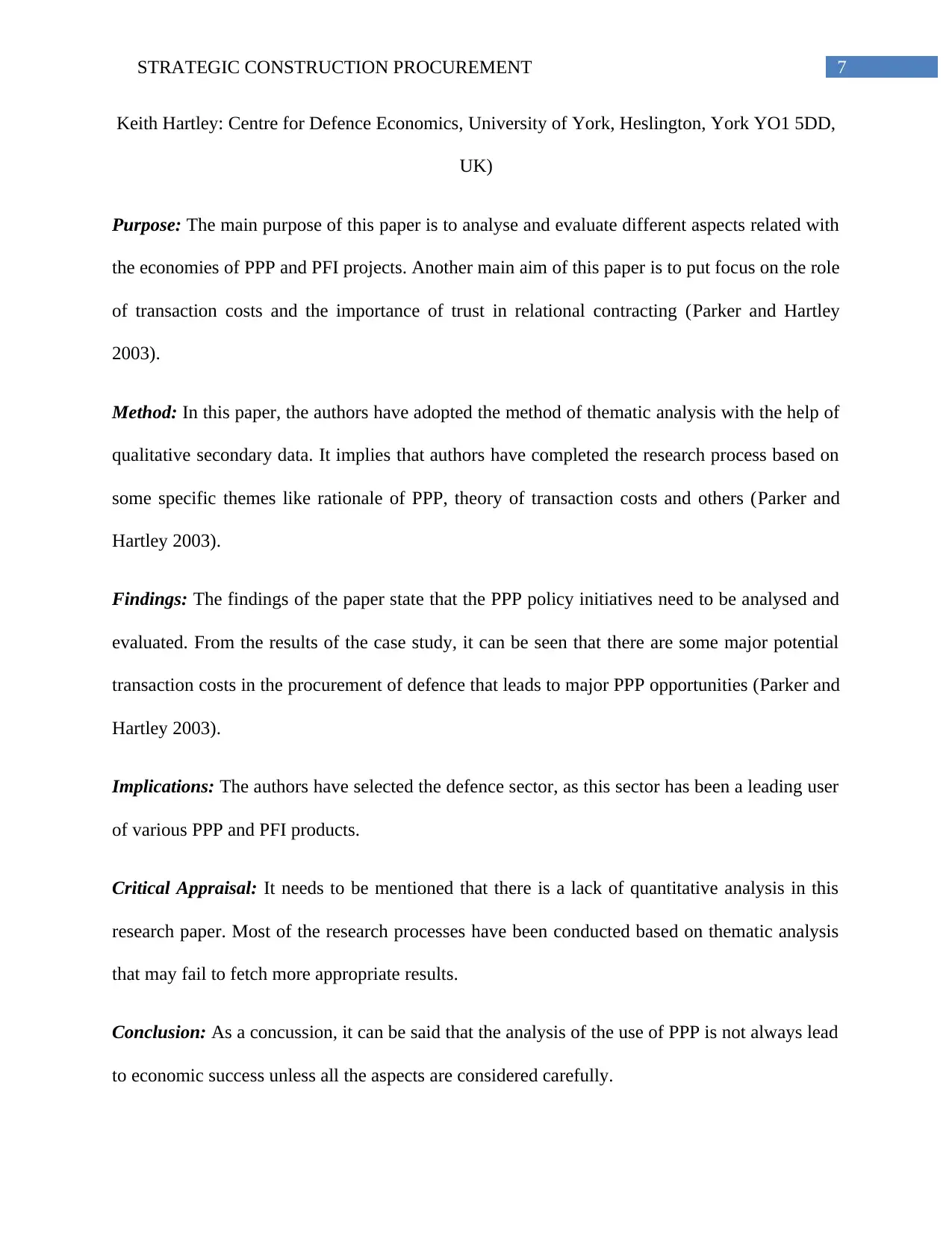
7STRATEGIC CONSTRUCTION PROCUREMENT
Keith Hartley: Centre for Defence Economics, University of York, Heslington, York YO1 5DD,
UK)
Purpose: The main purpose of this paper is to analyse and evaluate different aspects related with
the economies of PPP and PFI projects. Another main aim of this paper is to put focus on the role
of transaction costs and the importance of trust in relational contracting (Parker and Hartley
2003).
Method: In this paper, the authors have adopted the method of thematic analysis with the help of
qualitative secondary data. It implies that authors have completed the research process based on
some specific themes like rationale of PPP, theory of transaction costs and others (Parker and
Hartley 2003).
Findings: The findings of the paper state that the PPP policy initiatives need to be analysed and
evaluated. From the results of the case study, it can be seen that there are some major potential
transaction costs in the procurement of defence that leads to major PPP opportunities (Parker and
Hartley 2003).
Implications: The authors have selected the defence sector, as this sector has been a leading user
of various PPP and PFI products.
Critical Appraisal: It needs to be mentioned that there is a lack of quantitative analysis in this
research paper. Most of the research processes have been conducted based on thematic analysis
that may fail to fetch more appropriate results.
Conclusion: As a concussion, it can be said that the analysis of the use of PPP is not always lead
to economic success unless all the aspects are considered carefully.
Keith Hartley: Centre for Defence Economics, University of York, Heslington, York YO1 5DD,
UK)
Purpose: The main purpose of this paper is to analyse and evaluate different aspects related with
the economies of PPP and PFI projects. Another main aim of this paper is to put focus on the role
of transaction costs and the importance of trust in relational contracting (Parker and Hartley
2003).
Method: In this paper, the authors have adopted the method of thematic analysis with the help of
qualitative secondary data. It implies that authors have completed the research process based on
some specific themes like rationale of PPP, theory of transaction costs and others (Parker and
Hartley 2003).
Findings: The findings of the paper state that the PPP policy initiatives need to be analysed and
evaluated. From the results of the case study, it can be seen that there are some major potential
transaction costs in the procurement of defence that leads to major PPP opportunities (Parker and
Hartley 2003).
Implications: The authors have selected the defence sector, as this sector has been a leading user
of various PPP and PFI products.
Critical Appraisal: It needs to be mentioned that there is a lack of quantitative analysis in this
research paper. Most of the research processes have been conducted based on thematic analysis
that may fail to fetch more appropriate results.
Conclusion: As a concussion, it can be said that the analysis of the use of PPP is not always lead
to economic success unless all the aspects are considered carefully.
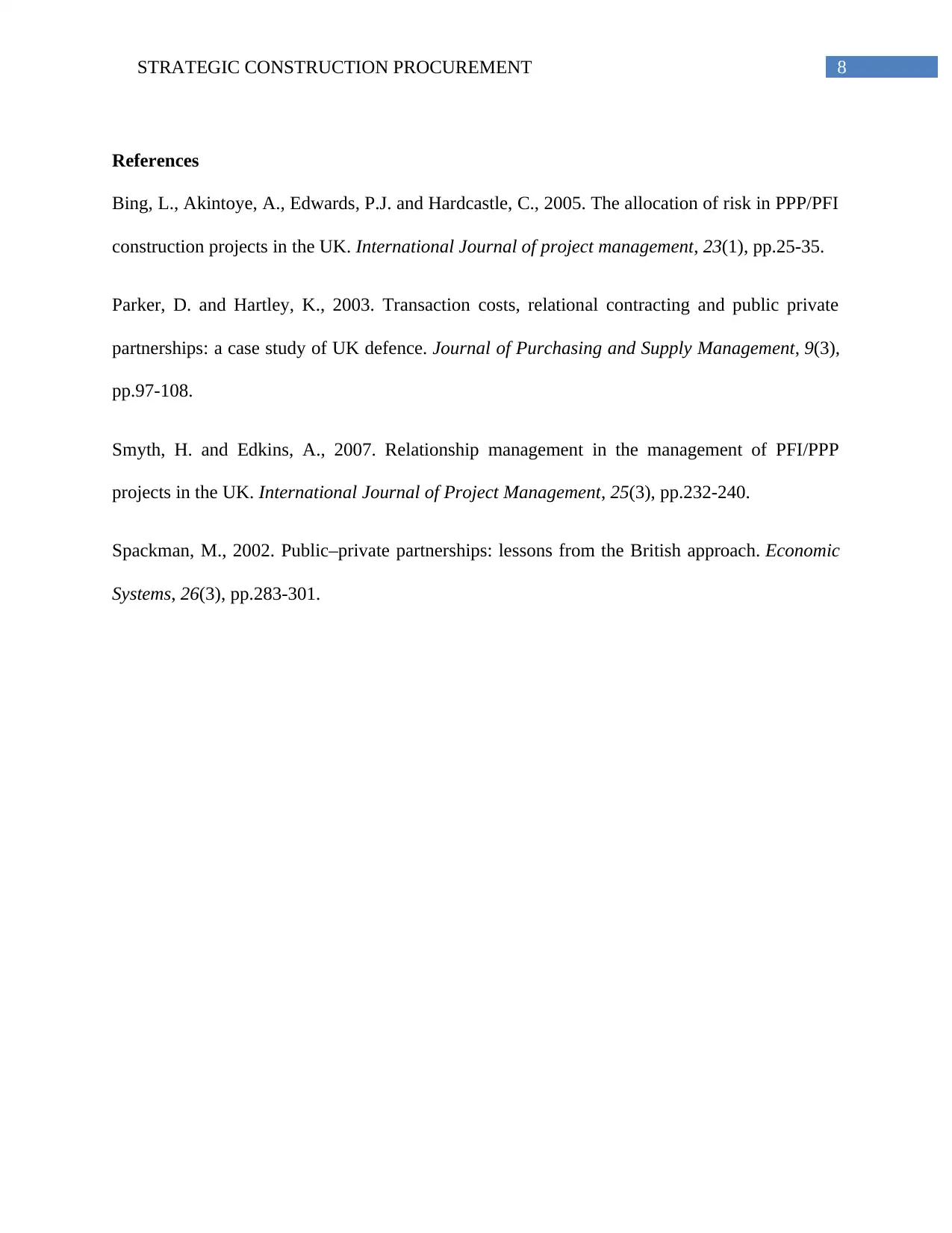
8STRATEGIC CONSTRUCTION PROCUREMENT
References
Bing, L., Akintoye, A., Edwards, P.J. and Hardcastle, C., 2005. The allocation of risk in PPP/PFI
construction projects in the UK. International Journal of project management, 23(1), pp.25-35.
Parker, D. and Hartley, K., 2003. Transaction costs, relational contracting and public private
partnerships: a case study of UK defence. Journal of Purchasing and Supply Management, 9(3),
pp.97-108.
Smyth, H. and Edkins, A., 2007. Relationship management in the management of PFI/PPP
projects in the UK. International Journal of Project Management, 25(3), pp.232-240.
Spackman, M., 2002. Public–private partnerships: lessons from the British approach. Economic
Systems, 26(3), pp.283-301.
References
Bing, L., Akintoye, A., Edwards, P.J. and Hardcastle, C., 2005. The allocation of risk in PPP/PFI
construction projects in the UK. International Journal of project management, 23(1), pp.25-35.
Parker, D. and Hartley, K., 2003. Transaction costs, relational contracting and public private
partnerships: a case study of UK defence. Journal of Purchasing and Supply Management, 9(3),
pp.97-108.
Smyth, H. and Edkins, A., 2007. Relationship management in the management of PFI/PPP
projects in the UK. International Journal of Project Management, 25(3), pp.232-240.
Spackman, M., 2002. Public–private partnerships: lessons from the British approach. Economic
Systems, 26(3), pp.283-301.
⊘ This is a preview!⊘
Do you want full access?
Subscribe today to unlock all pages.

Trusted by 1+ million students worldwide
1 out of 9
Your All-in-One AI-Powered Toolkit for Academic Success.
+13062052269
info@desklib.com
Available 24*7 on WhatsApp / Email
![[object Object]](/_next/static/media/star-bottom.7253800d.svg)
Unlock your academic potential
Copyright © 2020–2025 A2Z Services. All Rights Reserved. Developed and managed by ZUCOL.

